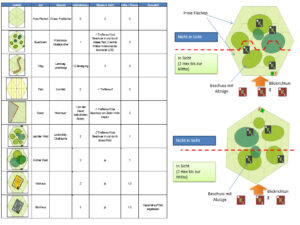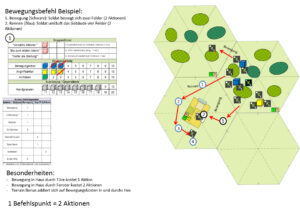Read the history of Assault – Red Horizon 41:

Part 1: The Background
Welcome to our new section: The Designer’s Journal. Peek behind the curtain with us. What is going through a designer’s head? How did the idea come about and where is it leading in the future?
My name is Wolfgang. I am 38 years old, a father of three sons, and married to a very, very patient woman. I come from a small town in Niederbayern, down in the Bavarian Forest. Red Horizon 41 is the first module in a new tactical wargame system (Assault) that simulates battles on the tactical level during the beginning phases of Operation Barbarossa in 1941. We are primarily concerned with depth and scalability relative to the length of play.
After concluding my military service in 2003, I was in the USA for an extended period of time and spent a good deal of time playing Panzer Grenadier and Lock ’n Load Band of Brothers, among others. For a time I also had a nice collection of Advanced Squad Leader (ASL) modules at home. I have to admit, I liked the theme of ASL, but it was hard finding opponents for this game, mainly because of the effort required to learn and understand it. And the acronyms alone were enough to drive you crazy. So in the end, I sold off all of my ASL gear.
For a time, we were playing Band of Brothers regularly. A good and solid game, but after a while the scenarios included were always the same setup. The fact that infantry without anti-armor weapons didn’t stand a chance against tanks, was a bit of frustrating game mechanics to us. And the one game mechanic, whereby a tank’s crew would exit the armored vehicle when being fired upon so that they could themselves be shot, was less than satisfying. Needless to say, the tank was left without a scratch. Regardless, Lock ’n Load is a solid and very good tactical-level wargame that kept us deeply occupied.
Since the scenarios included with Lock ’n Load got boring after a while and we found that we’d rather stage battles with units of our own choosing, I started to develop a “Battle Generator” for Lock ’n Load in 2013. I came came up with a method to calculate a point value for a unit based on it’s abilities and with this, I was able to create a “Point List” for the units in all the Lock ’n Load modules.
Choosing the units was just half the battle; it needed to be played on a randomly created map as well. So I made a list of the individual maps boards, provided standard objective hexes, and put together the first Lock ’n Load Random Battle Generator. Now my friends and I could finally play battles that we created with units that we ourselves had selected.
What can I say? That was not the end of our customization. It didn’t take long for us to come to the conclusion that a long cohesive campaign would be a lot of fun. We looked back to the old computer game era: Panzer Strike (C64) and Steel Panthers (PC) left a lasting influence on us and thought about something along these lines, only in board game form. We said to ourselves “The Lock ’n Load system could really work for this!”
That was the beginning of the creative process and after a short time, the framework for the Campaign system was finished. We wanted the players to be able to take a small group of troops from a pool of selected units through a series of scenarios, where they would take losses and damage from battle to battle. But these troops would also gain experience and they could also get replacements and be brought back up to strength. There was the logistical side to deal with as well, for example attrition, morale, combat readiness, supply, etc.
One turn in the Campaign consists of a Morning, Evening, and Night phase. The players need to activate their troops with hidden order markers in every phase. Then a matrix will determine what happens. The objectives of the Campaign were either to eliminate enough enemy units that their morale collapsed or to break through the front line.
Now, I hear you asking the question: “What does any of this have to do with Assault – Red Horizon 41?” Well, at first, nothing! But we found that the Lock ’n Load system did not give us enough creative room. For one, the units included in the module were too restricted. Secondly, parts of the game mechanics did not work very smoothly from our point of view. During this time, I came into contact with the the owner of Lock ’n Load Publishing and now, Random Battle Generators have been published for nearly all Lock ’n Load modules.

In 2015 I started to think: “If I were to design my own system, then I could make it exactly like I want!” A thought whose consequences I have not yet been able to clearly assess. I dropped the campaign module for Lock ’n Load and began to create a new wargame system.



The foundation for “Assault – Red Horizon” had been laid. My partners, Erich and Michael, were ready….
Part 3: July 2014 to November 2014
The first plan was to design a tactical wargame in which each individual soldier was represented by a wooden cube. We had the old “Steel Panthers” in mind, as well as “Close Combat” and “Combat Mission.” “A combination of these three would be perfect!” we thought to ourselves.

For the first attempt, we had planned a small-scaled approach. For instance, the buildings would have several rooms, windows and doors, as well as varying number of floors. A vehicle had individual crew members and different abilities, areas of technical specialization, and functions. All soldiers were portrayed as wooden cubes. An infantry troop consisted of 10 cubes (1 group leader, 9 riflemen). Every cube would indicate the soldiers status, depending on which side was showing. Therefore, individual soldiers could be wounded or killed. And the breakdown of machinery in the vehicles and artillery could limit or completely destroy the functions of these units.



1st Draft for Vehicles
We wanted to have a scenario landscape that was as modular as possible, meaning the game set up was completely free-form. This would give countless possibilities for setting up a scenario. Standard terrain types were then developed. These pieces would, however, have to be compatible to each other in every direction. During all of this, we always had our Campaign concept in mind. Our tactical system should later also fit to Campaign games.

The rules were layed out in tables. A soldier could move in different ways and perform different actions. There were Group Orders to move a whole group of blocks. The order system consisted of markers, which were placed concealed on the units in the Planning Phase. During the battle, the players took turns performing actions. This should eventually simulate delays in orders. The individual status of a soldier were indicated on the six sides of the soldier’s cube.

After hours and hours graphic work on the computer, printing and a near eternity of putting everything together, the first prototype was born: Design #1. I was already looking forward to playing the first battle.
But wait. How do the Orders, Units, and Weapons even work? For that we first had to at least come up with some basic rules or better overall terms, so we had tables with outlines and flowcharts. The rules should develop from the feel of the game and the situations that arise. We attempted to build the weapons’ game abilities and functions from the actual real-life specifications. And here we finally needed a break to assess the strength of each individual weapon. This was our starting point.




In just the first turn of the scenario, we were already having a good amount of fun. You could really put yourself in the situation of the wooden soldier cubes. Groups of soldiers advanced from hex to hex under armored support. The goal was to take an enemy defensive position on the edge of the forest. An anti-tank cannon and accompanying infantry opened up the fight. We had the first losses. A medic took care of the wounded and it kept going. Then there was a hit on the light tank—the engine, cannon and track were damaged. The medium tank put everything he could on the AT cannon. The crew leader and a crew member were wounded. The order to advance further was given.



That’s the gist of our first party. It sounds pretty action-packed, doesn’t it? In actuality, it was so. However, games tended to last a very long time because of the large amount of cubes (soldiers) and the detail of the rules. We had to come up with a way to reduce the playing time.
Part 3: to be continued…